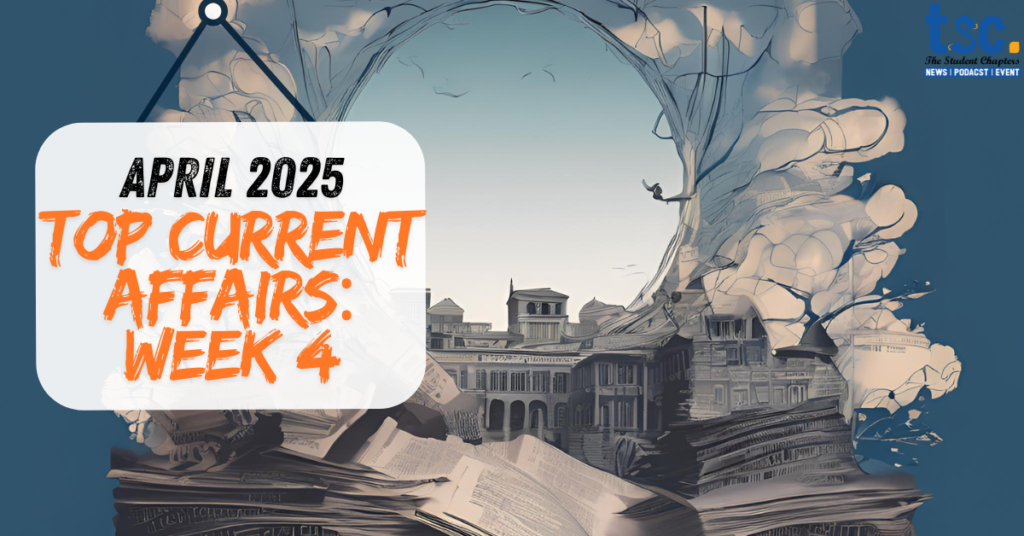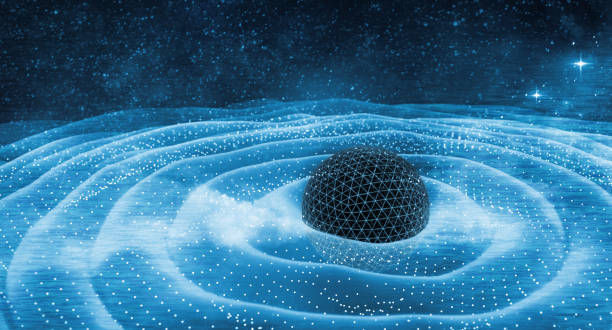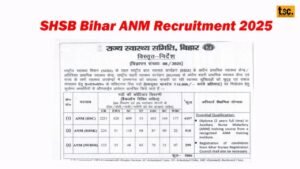Must-Know Current Affairs: May 2025 Week 4 for Exams

Stay ahead in UPSC, SSC, and Banking exams with the latest current affairs for May 2025. Week 4 covers groundbreaking developments in space exploration, defense, technology, and India’s cultural heritage, offering critical insights for aspirants. From the potential habitability of exoplanet K2-18b to the UNESCO recognition of the Bhagavad Gita, these updates are essential for boosting your general knowledge and exam performance.
Planet K2-18b Deemed Potentially Habitable
In May 2025, research using the James Webb Space Telescope suggested that exoplanet K2-18b, located 124 light years away in the Leo constellation, may be habitable due to the detection of dimethyl sulphide (DMS), a biomarker linked to life on Earth.
-
Findings: K2-18b’s hydrogen-rich atmosphere and Earth-like stellar radiation suggest conditions suitable for liquid water, a key requirement for life.
-
Significance: Advances astrobiology and the search for extraterrestrial life, a growing topic in UPSC science sections.
-
Challenges: The findings are suggestive, not definitive, and the planet’s distance limits direct exploration.
-
Technology: The James Webb’s spectroscopy enabled precise atmospheric analysis, highlighting advancements in space tech.
This discovery underscores the potential for life beyond Earth, a key focus for exam questions on space exploration.
Exam Tip: Focus on the distinction between games of skill and chance, and federalism issues for UPSC polity questions. Explore our Current Affairs for more.
ESA’s Biomass Mission Launched
In April 2025, the European Space Agency (ESA) launched the Biomass Mission to map global forest carbon using a P-band Synthetic Aperture Radar (SAR), addressing the loss of 3.7 million hectares of forests in 2023 (FAO, 2024).
-
Objective: Measures forest biomass and carbon storage to enhance understanding of the global carbon cycle.
-
Technology: A 12-meter antenna penetrates dense canopies, providing accurate data on forest density and height.
-
Environmental Impact: Informs deforestation policies and CO₂ mitigation strategies, critical for climate change questions.
-
Context: Fills global biomass data gaps, supporting Paris Agreement goals and India’s forest conservation efforts.
The Biomass Mission is vital for environmental governance and international cooperation topics in competitive exams.
Exam Tip: Note the DPDP Act’s impact on RTI and judicial precedents for UPSC governance questions. Check our Governance Updates for related topics.
Fram2 Mission Completes Polar Orbit
In May 2025, the private Fram2 mission, led by cryptocurrency billionaire Chun Wang, completed the first human polar orbit, a 3.5-day mission launched by SpaceX’s Falcon 9 and Dragon capsule.
-
Firsts: Achieved the first human polar orbit and Pacific splashdown, conducting 22 experiments, including the first human X-ray in orbit.
-
Scientific Impact: Advances microgravity research, relevant for space science questions.
-
Context: Named after the Norwegian ship Fram, the mission highlights the rise of private space exploration.
-
Significance: Demonstrates growing accessibility of space, a key topic for UPSC science and technology sections.
Fram2’s success underscores the privatization of space, a trending exam topic.
GPS Spoofing Affects IAF Aircraft

In May 2025, an Indian Air Force (IAF) aircraft faced GPS spoofing during a relief mission to Myanmar, exposing vulnerabilities in navigation systems.
-
Mechanism: Fake signals override weak GPS satellite signals, misleading navigation systems.
-
Security Implications: Endangers aircraft and ships, prompting the need for anti-spoofing technologies like signal encryption.
-
Context: Increasing spoofing incidents in conflict zones, such as Ukraine and the Middle East, highlight global cyber threats.
-
Exam Relevance: Critical for defense and cybersecurity questions in competitive exams.
This incident emphasizes the need for robust navigation systems, a key focus for aspirants.
Exam Tip: Focus on agriculture’s economic role and climate change impacts for UPSC economy and environment questions. Explore our Updates for more. Source: ICAR-NIAP.
Undersea Cables Boost India’s Internet
In May 2025, Bharti Airtel landed the 2Africa Pearls cable in Mumbai, adding 100 Tbps to India’s internet bandwidth, supporting its $10 trillion digital economy.
-
Infrastructure: India hosts 17 international cable systems, with hubs in Mumbai and Chennai; projects like 2Africa, IAX, and IEX aim to quadruple capacity.
-
Strategic Risks: 95% of cables pass through the Juhu-Versova chokepoint, a single failure point; India handles 20% of global traffic with only 3% of cables.
-
Significance: Enhances connectivity to Europe, Africa, and Asia, vital for digital economy questions.
-
Exam Relevance: Key for infrastructure and economic development topics.
Undersea cables are crucial for India’s digital growth, a must-know for aspirants.
Quantum Gravity Gradiometer Proposed

In May 2025, NASA proposed a quantum gravity gradiometer (QGG) for satellites to detect minute gravitational variations using quantum mechanics.
-
Technology: Measures changes in Earth’s mass distribution, such as water, ice, and rock movements.
-
Applications: Tracks climate change impacts and detects underground bunkers or tunnels for security.
-
Impact: Enhances disaster resilience and climate monitoring, relevant for science and environment questions.
-
Context: Builds on NASA’s GRACE mission, improving precision in Earth observation.
The QGG proposal highlights quantum technology advancements, a key exam topic.
Vehicle-to-Grid Technology Piloted in Kerala
In May 2025, Kerala and IIT Bombay launched a Vehicle-to-Grid (V2G) pilot, integrating electric vehicles (EVs) with the power grid using bidirectional chargers.
-
Technology: EVs act as decentralized energy storage, sending power back to the grid during peak demand.
-
Challenges: Limited bidirectional charging infrastructure and lack of regulatory support.
-
Significance: Stabilizes grid supply-demand, supports EV adoption, and aligns with India’s green energy goals.
-
Exam Relevance: Important for energy and sustainability questions.
V2G technology showcases India’s renewable energy innovation, vital for aspirants.
Source: Drishti IAS.
Laser Detects Radioactive Materials Remotely
In May 2025, US physicists demonstrated long-range detection of radioactive materials using carbon-dioxide lasers, with potential applications in India.
-
Technology: Lasers induce electron avalanches to detect alpha particles, scalable for gamma rays over 100 meters.
-
Applications: Enhances security at borders and airports; monitors environmental contamination.
-
Significance: Improves nuclear safety and environmental monitoring, relevant for science and security questions.
-
Context: Complements India’s radiation monitoring efforts post-2024 nuclear safety audits.
This breakthrough strengthens global safety measures, a key exam topic.
Sahastra Shakti Laser Weapon Tested
In May 2025, DRDO successfully tested the 30-kW Sahastra Shakti laser weapon, designed to counter drones and missiles within 5 km.
-
Features: Combines six 5-kW lasers for 360-degree targeting, disabling UAVs, sensors, and helicopters.
-
Strategic Impact: Positions India alongside the US, Russia, and China in laser defense technology.
-
Cost Efficiency: Reduces reliance on expensive ammunition, saving ₹50-100 crore annually (DRDO, 2025).
-
Exam Relevance: Key for defense and indigenous technology questions.
Sahastra Shakti enhances India’s air defense, a critical topic for aspirants.
Rafale-M Jets Deal Signed with France

In April 2025, India signed a ₹64,000 crore deal with France for 26 Rafale-M jets, with deliveries starting mid-2028.
-
Details: Includes 22 single-seater and 4 twin-seater jets for INS Vikrant and Vikramaditya, armed with Exocet and Meteor missiles.
-
Strategic Impact: Bolsters naval air defense and deepens Indo-French defense ties.
-
Context: Complements India’s 36 Rafale jets for IAF, enhancing 4.5th-generation capabilities.
-
Exam Relevance: Important for defense and international relations questions.
The Rafale-M deal strengthens India’s maritime security, a key exam focus.
BrahMos Missiles Delivered to Philippines

In May 2025, India delivered a second batch of BrahMos supersonic missiles to the Philippines, fulfilling a $375 million 2022 contract.
-
Details: Mach 2.8 missiles enhance coastal defense and anti-ship capabilities.
-
Strategic Impact: Boosts India’s defense export profile and Indo-Pacific security ties.
-
Context: Follows the first batch delivered in 2024, strengthening bilateral relations.
-
Exam Relevance: Key for defense exports and regional security questions.
BrahMos exports highlight India’s growing defense industry, vital for aspirants.
Labour Needs Focus in Capital-Intensive India
In May 2025, India faced a formal sector job deficit of 50 lakh annually since 2017-18, driven by capital-intensive production despite a labor-abundant economy.
-
Causes: Automation and global competition reduce labor demand, with 60% of firms adopting machinery (CMIE, 2024).
-
Trends: Informal self-employment rises in rural areas, accounting for 45% of jobs.
-
Solutions: Enhance ITIs, link funding to job creation, and reform labor laws for flexibility.
-
Exam Relevance: Critical for economic and social issues questions.
This issue underscores India’s employment challenges, a key exam topic.
Chhatrapati Shivaji’s Legacy Highlighted

In May 2025, cultural events celebrated Chhatrapati Shivaji’s contributions to Maratha governance and military strategy in the 17th century.
-
Administration: Established efficient revenue and justice systems, known as Ashta Pradhan.
-
Navy: Pioneered naval warfare with coastal forts like Sindhudurg, countering foreign powers.
-
Significance: Symbolizes resistance against Mughal rule, inspiring modern governance narratives.
-
Exam Relevance: Key for medieval history and cultural heritage questions.
Shivaji’s legacy remains a cornerstone of Indian history for aspirants.
Dr. Bhim Rao Ambedkar’s Role Emphasized

In May 2025, Dr. Ambedkar’s contributions to India’s Constitution and social justice were highlighted in national discourse.
-
Contributions: Architect of India’s democratic framework and champion of Dalit rights.
-
Legacy: Inspires modern inclusion policies and education-driven empowerment.
-
Context: His 1956 Buddhist conversion continues to influence social reform movements.
-
Exam Relevance: Essential for modern history and social justice questions.
Ambedkar’s work is a must-know for competitive exams.
Raja Ravi Varma’s Art Celebrated
In May 2025, Raja Ravi Varma’s 19th-century paintings, blending Indian themes with Western realism, were celebrated in exhibitions.
-
Style: Introduced oil painting and lithographs, making art accessible via prints.
-
Cultural Impact: Shapes modern Indian visual culture, influencing contemporary artists.
-
Context: His works, like Shakuntala, remain iconic in Indian art history.
-
Exam Relevance: Key for art and culture questions.
Varma’s legacy highlights India’s artistic heritage, vital for aspirants.
Mahabodhi Temple’s UNESCO Status Reinforced
In May 2025, the Mahabodhi Temple in Bodh Gaya, marking Buddha’s enlightenment, had its UNESCO World Heritage status emphasized.
-
Significance: A major Buddhist pilgrimage site, listed for cultural and religious value.
-
Cultural Impact: Attracts global devotees, preserving ancient architecture.
-
Challenges: Balancing tourism with conservation requires ongoing maintenance.
-
Exam Relevance: Important for cultural heritage and ancient history questions.
The temple’s global significance is a key exam topic.
Sattriya Dance Gains Recognition
In May 2025, Sattriya, an Assamese classical dance developed in 15th-century Vaishnava monasteries, gained national and international acclaim.
-
Features: Combines drama, music, and devotional themes, rooted in Assam’s cultural heritage.
-
Cultural Impact: Preserves Assam’s traditions and gains global recognition through festivals.
-
Context: One of eight Indian classical dances, alongside Bharatanatyam and Kathak.
-
Exam Relevance: Key for art and culture questions.
Sattriya’s recognition highlights India’s diverse cultural heritage for aspirants.
Bhagavad Gita, Natyashastra in UNESCO Register

In May 2025, the Bhagavad Gita and Natyashastra were added to UNESCO’s Memory of the World Register, recognizing their universal value.
-
Gita: A philosophical guide on duty and spirituality, part of the Mahabharata.
-
Natyashastra: An ancient treatise on performing arts, influencing Indian theater and dance.
-
Global Impact: Ensures preservation and accessibility of India’s intellectual heritage.
-
Exam Relevance: Crucial for cultural heritage and ancient history questions.
This recognition elevates India’s cultural legacy, a must-know for competitive exams.
Conclusion
These current affairs for May 2025 are vital for competitive exam aspirants. From space exploration to defense advancements and cultural milestones, these updates shape India’s global and domestic landscape. Visit our exam prep resources and share your insights in the comments to enhance your preparation!
Additional Resources for Exam Preparation
- Related Topics: Explore our Current Affairs Section for exam-relevant content.
Stay Updated: Subscribe to our newsletter for monthly current affairs updates and exam tips tailored for competitive exams.
Don’t miss out! Learn how student chapters can provide networking opportunities and professional growth. Click to read and join our WhatsApp community!
Not sure which career to choose? Our professionals can guide you. Book your counselling session now on Mytagapp.com!









